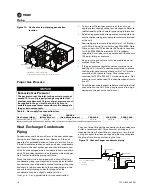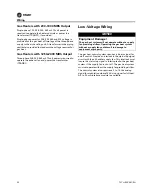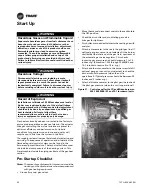
26
CLCH-SVX08C-EN
Start Up
Gas heat sections have been run-tested in the factory to
assure proper operation and ease of startup. The actuator
linkages controlling the air–fuel mixture are preset for
optimum efficiency and performance, but jobsite
conditions for gas pressure, volume, and quality will
require you to fine tune the system in the field.
Thoroughly review all service literature before startup and
servicing. The sequence of operation and all details of the
flame-safeguard control system can be found in the
burner equipment literature. The technical bulletins cover
the individual components of the heating system. This
literature ships inside the piping vestibule of the gas heat
section.
Pre-Startup Checklist
Note:
The procedures discussed in this section should be
done by qualified technicians who are experienced
with gas heating equipment.
•
Close all manual gas valves.
•
Move the manual disconnect switch in the vestibule to
the OFF position.
•
Check the air shutter and modulating gas valve
linkages for tightness.
•
Air shutter may need adjustment when setting up with
analyzer.
•
Attach a manometer to the tee in the pilot gas line (if
optional gauge or sensor is not selected) in the burner
vestibule at the inlet end of the gas train, upstream of
the automatic gas valve/regulator. This checks
incoming gas pressure and should measure 7 to 14
inches w.g. (Exception: 1250 through 2000 MBh and
10:1 turndown require 9 to 14 in. w.g.)
•
Attach another manometer to the burner manifold (if
optional gauge or sensor is not selected) to check the
burner manifold pressure (when the unit is
operational). (Typical pressure should be between 2.5
inches and 3 inches w.g.)
•
Attach a third manometer to the pilot gas line to check
the pilot gas pressure (when the unit is operational).
WARNING
Hazardous Gases and Flammable Vapors!
Exposure to hazardous gases from fuel substances have
been shown to cause cancer, birth defects or other
reproductive harm. Improper installation, adjustment,
alteration, service or use of this product could cause
flammable mixtures or lead to excessive carbon
monoxide. To avoid hazardous gases and flammable
vapors follow proper installation and set up of this
product and all warnings as provided in this manual.
Failure to follow all instructions could result in death or
serious injury.
WARNING
Hazardous Voltage!
Disconnect all electric power, including remote
disconnects before servicing. Follow proper lockout/
tagout procedures to ensure the power can not be
inadvertently energized. Failure to disconnect power
before servicing could result in death or serious injury.
WARNING
Hazard of Explosion!
Installations at altitudes of 3,000 feet above sea level or
higher may require adjustment of the air-fuel linkage
for proper combustion. Linkage and air-fuel adjustment
should only be done by an experienced, qualified gas
heat technician. Failure to follow these
recommendations could result in death or serious
injury or equipment or property-only damage.
Figure 21.
Control panel for the JR and Midco burner on
200-1000 MBh (3:1 and10:1 turndown) units




































